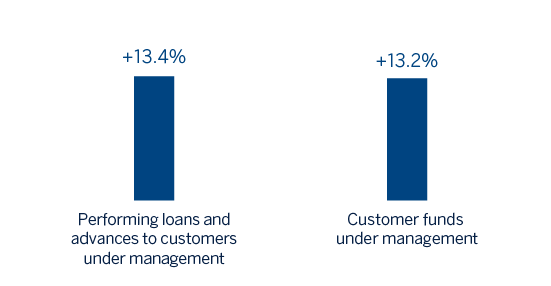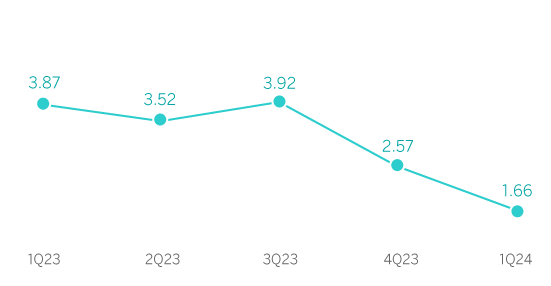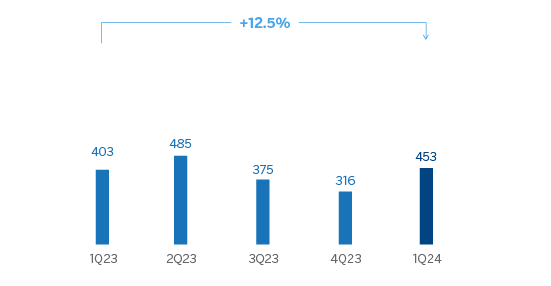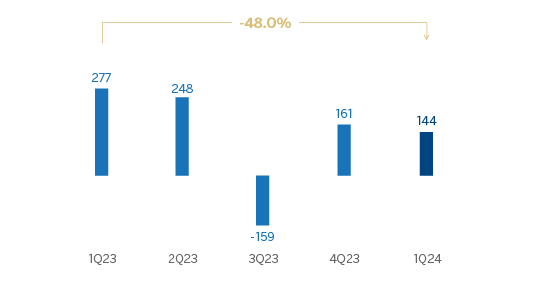Turkey
Highlights
- Growth in lending and customer funds
- NPL ratio improvement
- Favorable year-on-year evolution of recurring income
- Lower hyperinflation impact
BUSINESS ACTIVITY (1)
(VARIATION AT CONSTANT EXCHANGE RATE COMPARED TO 31-12-23)

(1) Excluding repos.
NET INTEREST INCOME / AVERAGE TOTAL ASSETS
(PERCENTAGE AT CONSTANT EXCHANGE RATE)

OPERATING INCOME
(MILLIONS OF EUROS AT CURRENT EXCHANGE RATE)

NET ATTRIBUTABLE PROFIT (LOSS)
(MILLIONS OF EUROS AT CURRENT EXCHANGE RATE)

| FINANCIAL STATEMENTS AND RELEVANT BUSINESS INDICATORS (MILLIONS OF EUROS AND PERCENTAGE) | ||||
|---|---|---|---|---|
| Income statement | 1Q24 | ∆ % | ∆ % (2) | 1Q23 (1) |
| Net interest income | 277 | (55.7) | (27.2) | 626 |
| Net fees and commissions | 423 | 145.9 | n.s. | 172 |
| Net trading income | 316 | 41.1 | 131.0 | 224 |
| Other operating income and expenses | (119) | (46.1) | (70.3) | (220) |
| Gross income | 897 | 11.9 | n.s. | 802 |
| Operating expenses | (444) | 11.3 | 79.3 | (399) |
| Personnel expenses | (254) | 21.7 | 100.5 | (209) |
| Other administrative expenses | (146) | (5.5) | 55.6 | (154) |
| Depreciation | (45) | 23.2 | 62.3 | (36) |
| Operating income | 453 | 12.5 | n.s. | 403 |
| Impairment on financial assets not measured at fair value through profit or loss | (75) | 26.5 | 109.1 | (59) |
| Provisions or reversal of provisions and other results | 36 | n.s. | n.s. | (16) |
| Profit (loss) before tax | 413 | 26.4 | n.s. | 327 |
| Income tax | (244) | n.s. | n.s. | (5) |
| Profit (loss) for the period | 170 | (47.3) | n.s. | 322 |
| Non-controlling interests | (26) | (43.0) | n.s. | (45) |
| Net attributable profit (loss) | 144 | (48.0) | n.s. | 277 |
Balance sheets | 31-03-24 | ∆ % | ∆ % (2) | 31-12-23 |
| Cash, cash balances at central banks and other demand deposits | 8,187 | (15.6) | (9.7) | 9,700 |
| Financial assets designated at fair value | 3,943 | 6.8 | 14.3 | 3,692 |
| Of which: Loans and advances | 2 | (2.6) | 4.2 | 2 |
| Financial assets at amortized cost | 55,727 | 8.1 | 15.7 | 51,543 |
| Of which: Loans and advances to customers | 39,636 | 5.9 | 13.4 | 37,416 |
| Tangible assets | 1,630 | 9.0 | 14.2 | 1,496 |
| Other assets | 1,901 | 0.1 | 6.9 | 1,899 |
| Total assets/liabilities and equity | 71,389 | 4.5 | 11.8 | 68,329 |
| Financial liabilities held for trading and designated at fair value through profit or loss | 1,919 | 2.2 | 9.3 | 1,878 |
| Deposits from central banks and credit institutions | 2,116 | (8.3) | (1.8) | 2,306 |
| Deposits from customers | 52,676 | 4.0 | 11.3 | 50,651 |
| Debt certificates | 3,115 | 13.8 | 21.8 | 2,737 |
| Other liabilities | 4,422 | 2.4 | 8.7 | 4,319 |
| Regulatory capital allocated | 7,143 | 11.0 | 18.7 | 6,438 |
Relevant business indicators | 31-03-24 | ∆ % | ∆ % (2) | 31-12-23 |
| Performing loans and advances to customers under management (3) | 39,546 | 5.9 | 13.4 | 37,339 |
| Non-performing loans | 1,896 | (3.5) | 3.3 | 1,965 |
| Customer deposits under management (3) | 50,388 | 2.2 | 9.3 | 49,321 |
| Off-balance sheet funds (4) | 9,988 | 28.6 | 37.6 | 7,768 |
| Risk-weighted assets | 58,558 | 7.4 | 14.9 | 54,506 |
| Efficiency ratio (%) | 49.5 | 47.0 | ||
| NPL ratio (%) | 3.4 | 3.8 | ||
| NPL coverage ratio (%) | 96 | 97 | ||
| Cost of risk (%) | 0.77 | 0.25 | ||
(1) Restated balances. For more information, please refer to the “Business Areas” section.
(2) At constant exchange rate.
(3) Excluding repos.
(4) Includes mutual funds and pension funds.
Macro and industry trends
Since the general elections held in May 2023, there are increasing signs of normalization in economic policy in general, and monetary policy in particular, which point to a gradual reversal of the current macroeconomic distortions. Thus, benchmark interest rates have increased from 8.5% at the beginning of 2023 to 50% in March 2024, and new countercyclical measures could be implemented in the next months in order to try to control inflation, which reached 68.5% in March 2024 on year-on-year terms, and allow for more stability of the Turkish lira. Economic growth is expected to moderate from 4.5% in 2023 to 3.5% in 2024 (unchanged from the previous forecasts), supported by a still expansive fiscal policy. Despite the uncertainty, it is likely that the pace of GDP growth will moderate, eventually easing the pressures on inflation, which will however remain at relatively high levels.
As for the Turkish banking system, the effect of inflation remains strong. Total lending in the system increased 53.3% on a year-on-year basis as of February 2024, at similar levels to the previous months. The credit stock continues to be driven by the increase of consumer finance and credit cards (+69.83% year-on-year) while credit to businesses grew slightly less (+50.26% year-on-year). Total deposits maintain their strength from the previous months and increased at the end of February by 60.2% on a year-on-year basis. The growth of Turkish lira deposits remains strong in the same month (+64.9%), while U.S. dollar deposits grew more slowly (+53.8%), but faster than in previous quarters, due to the easing from the central bank of several rules that promoted deposits in the local currency. Despite this, dollarization decreased to 40,4% in February 2024 versus 42.1% a year earlier. The system's NPL ratio has continued falling in the last months and as of February 2024 it was of 1.67% (40 basis points lower than in the same month of 2023). Capital indicators remained at more than comfortable levels on the same date.
Unless expressly stated otherwise, all comments below on rates of changes for both activity and results, will be presented at constant exchange rates. These rates, together with changes at current exchange rates, can be observed in the attached tables of the financial statements and relevant business indicators. For the conversion of these figures, the end of period exchange rate as of March 31, 2024 is used, reflecting the considerable depreciation by the Turkish lira in the last twelve months. Likewise, the Balance sheet, the Risk-Weighted Asset (RWA) and the equity are affected.
Activity
The most relevant aspects related to the area’s activity10 in the first quarter of 2024 were:
- Lending activity (performing loans under management) increased by 13.4%, mainly driven by the growth in Turkish lira loans (+15.6%) and, to a lesser extent, by the growth of foreign currency loans (+1.9%). Within loans in Turkish liras, the evolution of credit cards (+19.1%) and of consumer loans (+13.7%) stand out.
- In terms of asset quality, the NPL ratio decreased 36 basis points from that at the end of December 2023 to 3.4%, and 88 basis points compared to the figure as of the end of March 2023, mainly as a result of the growth in activity, the sale of a retail portfolio and the positive dynamics in the wholesale portfolio in recoveries and repayments, which offset higher net entries in the retail portfolio. The NPL coverage ratio recorded a decrease of 118 basis points in the quarter to 96% as of March 31, 2024.
- Customer deposits increased by 9.3%, mainly thanks to the performance of demand deposits in U.S. dollars (+8.2%), whose demand increased before the local elections taking place in March and, to a lesser extent, to the growth in Turkish lira deposits (+3.3%). Additionally, off-balance sheet funds had a remarkable evolution (+37.6%).
Results
Turkey generated a net attributable profit of €144m during the first quarter of 2024, which compares positively with the accumulated result reached at the end of March 2023 at constant exchange rate, both periods reflecting the impact of the application of hyperinflation accounting.
As mentioned above, the year-on-year comparison of the accumulated income statement at the end of March 2024 at current exchange rate is affected by the strong depreciation of the Turkish lira in the last year (-40.3%). Excluding this effect, the highlights of the results for the year at constant exchange rate are summarized below:
- Net interest income recorded a year-on-year fall, mainly due to the decline in the Turkish lira spread and greater wholesale funding costs, partially offset by the growth in Turkish lira loans and, as a novelty, the remuneration of certain reserves in Turkish lira from the central bank.
- Net fees and commissions increased significantly, favored by the performance in payment systems fees, brokerage activity, guarantees and asset management.
- NTI showed an excellent evolution thanks to higher results from derivatives, as well as to the increase in the results of the Global Markets unit and in foreign exchange operations.
- The other operating income and expenses line showed a balance of €-119m, which compares favorably with the previous year. This line includes, among others, the loss in the value of the net monetary position due to the country's inflation rate, which stood below the loss recorded in the first quarter of 2023, partially offset by the income derived from inflation-linked bonds (CPI linkers). It is also worth highlighting the improved performance of the results of Garanti BBVA´s subsidiaries, also included in this line.
- Operating expenses increased, mainly due to the growth in personnel expenses, linked to the growth in the workforce in 2023 and, to a lesser extent, to the increase in general expenses, highlighting the higher technology expenditure.
- Regarding the impairment on financial assets, it increased due to both higher requirements in retail portfolios and to recoveries in the wholesale segment, which, despite continuing to be relevant in terms of credit quality and repayments improvement, have not been as high as in the first quarter of 2023. Thus, the cumulative cost of risk as of March 31, 2024 increased to 0.77%, a more standard level after an abnormally low level in 2023.
- The provisions and other results line closed March 2024 with a release of 36 million euros, linked to remarkable recoveries in wholesale clients, which compare favorably with the previous year, due to the provisions constituted in the first quarter of 2023 as a result of the earthquake that affected an area in the south of Turkey.
- Lastly, the tax expense of March 2023 included the initial positive impact due to a legal change with regard to the revaluation, from the fiscal point of view, of real estate and other depreciable fixed assets of Garanti BBVA AS, which generated a credit in the corporate income tax rate registered at the time.
10 The variation rates of loans in Turkish lira and loans in foreign currency (U.S. dollars) only refer to Garanti Bank. Thus they exclude the subsidiaries of Garanti BBVA, mainly in Romania and Netherlands.